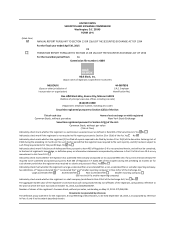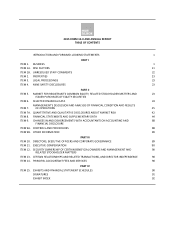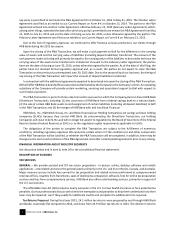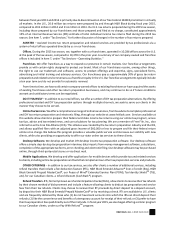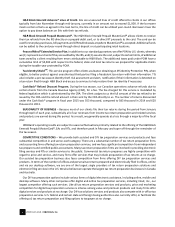HR Block 2015 Annual Report Download - page 14
Download and view the complete annual report
Please find page 14 of the 2015 HR Block annual report below. You can navigate through the pages in the report by either clicking on the pages listed below, or by using the keyword search tool below to find specific information within the annual report.
H&R Block, Inc. | 2015 Form 10-K 7
Bank Regulatory Capital Requirements. OCC regulations require HRB Bank to maintain specified minimum levels
of regulatory capital. To be well capitalized, a federal savings association must have a leverage ratio of at least 5.0%,
a Tier 1 risk-based capital ratio of at least 8.0% and a total risk-based capital ratio of at least 10.0%. To be adequately
capitalized, a federal savings association must have a leverage ratio of at least 4.0%, a Tier 1 risk-based capital ratio
of at least 6.0% and a total risk-based capital ratio of at least 8.0%. As of March 31, 2015, HRB Bank's most recent Call
Report, HRB Bank was well-capitalized, with a leverage ratio of 34.7%, a Tier 1 risk-based capital ratio of 234.7%, and
a total risk-based capital ratio of 236.0%. See Item 8, note 19 to the consolidated financial statements for discussion
of dividends paid by HRB Bank.
In July 2013, the federal banking agencies issued final rules to implement changes that would increase the capital
requirements for federal savings banks, including HRB Bank. The OCC has issued final capital regulations and the new
capital regulations became effective for HRB Bank on January 1, 2015. See discussion under the heading "Regulatory
Capital Requirements" below.
The OCC is authorized to take certain enforcement actions against federal savings banks that fail to meet the
minimum ratios for an adequately capitalized institution and to impose other restrictions on federal savings banks
that are less than adequately capitalized.
Regulatory Capital Requirements. In July 2013, the federal banking agencies issued final rules to implement changes
required by the Dodd-Frank Act and to conform to the Basel III regulatory capital framework (the Basel III Capital
Rules). The Basel III Capital Rules implement the Basel Committee's December 2010 framework known as "Basel III"
for strengthening international capital standards as well as certain provisions of the Dodd-Frank Act. The Basel III
Capital Rules substantially revise the risk-based capital requirements applicable to depository institutions, compared
to the current U.S. risk-based capital rules, and for the first time impose capital requirements on SLHCs. Our Holding
Companies are SLHCs because they control HRB Bank. The Basel III Capital Rules became effective for our Holding
Companies and HRB Bank on January 1, 2015, subject to phase-in periods as discussed below.
The Basel III Capital Rules, among other things, introduced a new capital measure called "Common Equity Tier 1,"
which will consist of common stock instruments and related surplus (net of treasury stock), retained earnings, and
subject to certain adjustments, minority common equity interests in subsidiaries (CET1). When fully phased in on
January 1, 2019, the Basel III Capital Rules will require SLHCs to maintain (1) a minimum ratio of CET1 to risk-weighted
assets of at least 4.5%, plus a 2.5% "capital conservation buffer" (which is added to the 4.5% CET1 ratio as that buffer
is phased in, effectively resulting in a minimum ratio of CET1 to risk-weighted assets of at least 7% upon full
implementation), (2) a minimum ratio of Tier 1 capital to risk-weighted assets of at least 6.0%, plus the capital
conservation buffer (which is added to the 6.0% Tier 1 capital ratio as that buffer is phased in, effectively resulting in
a minimum Tier 1 capital ratio of 8.5% upon full implementation), (3) a minimum ratio of total capital (that is, Tier 1
plus Tier 2) to risk-weighted assets of at least 8.0%, plus the capital conservation buffer (which is added to the 8.0%
total capital ratio as that buffer is phased in, effectively resulting in a minimum total capital ratio of 10.5% upon full
implementation) and (4) a minimum leverage ratio of 4%, calculated as the ratio of Tier 1 capital to average total
consolidated assets.
Under the Basel III Capital Rules, the initial minimum capital ratios that became effective on January 1, 2015 are
as follows:
4.5% CET1 to risk-weighted assets
6.0% Tier 1 capital to risk-weighted assets
8.0% Total capital to risk-weighted assets
4.0% leverage ratio
The Basel III Capital Rules provide for a number of deductions from and adjustments to CET1. Deductions from
CET1 include, among other items, goodwill and other intangibles and deferred tax assets, all net of associated deferred
tax liabilities. Under current capital standards, the effects of accumulated other comprehensive income items included
in capital are excluded for the purposes of determining regulatory capital ratios. Under the Basel III Capital Rules, the
effects of certain accumulated other comprehensive income items would flow through to regulatory capital; however,
certain banking organizations, including our Holding Companies and HRB Bank, may make a one-time permanent
election to continue to exclude these items. Implementation of the deductions and other adjustments to CET1 began




